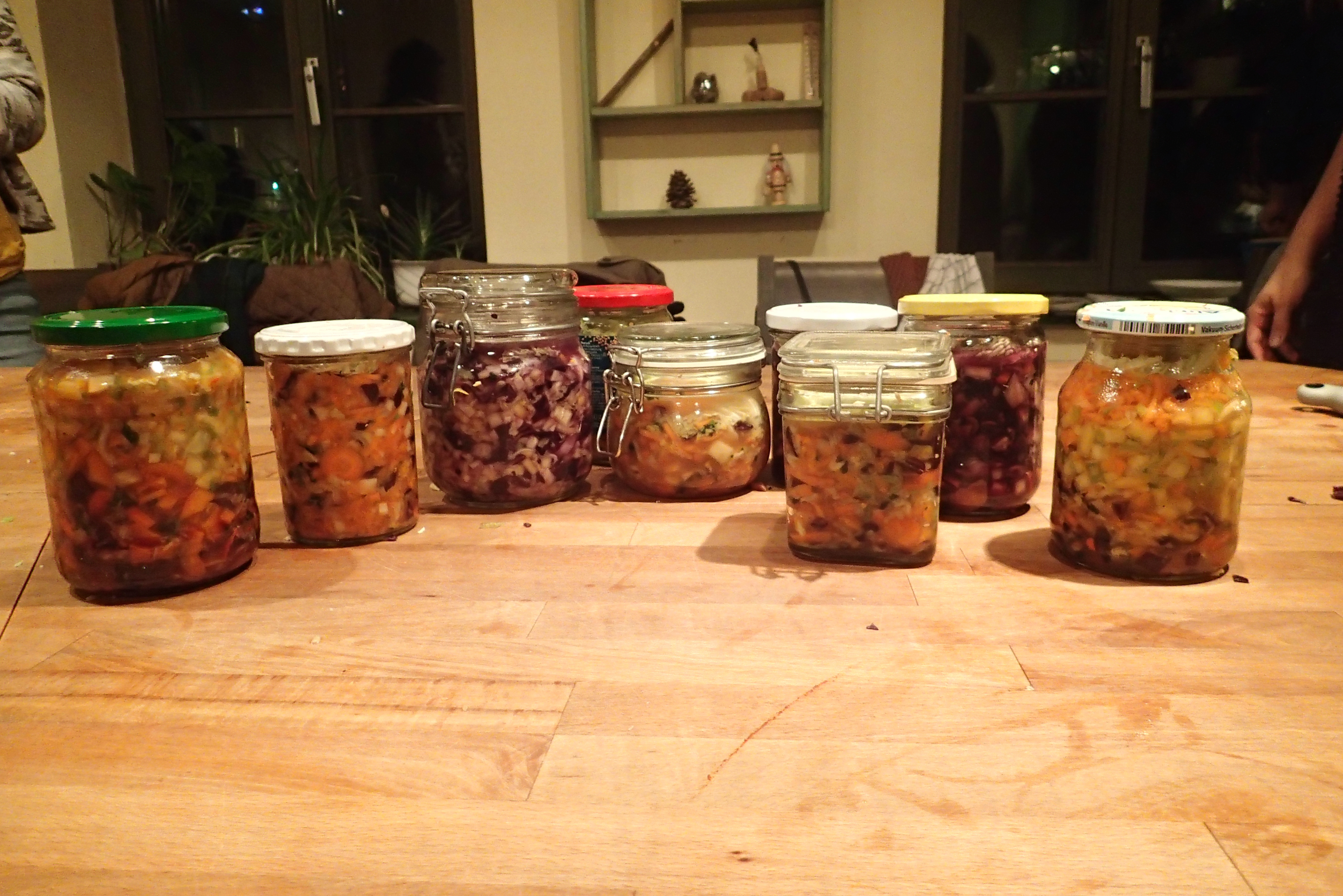 Essen tut ja jeder und verbindet Menschen. Am 19. und 26. Januar haben wir unsere Interkulturelle DIY Workshop-Reihe mit dem Thema Essen bzw. Lebensmittelverschwendung angefangen. Laut einer Studie der FAO (Ernährungs- und Landwirtschaftsorganisation der Vereinten Nationen) gehen rund 1,3 Millionen Tonnen Lebensmittel jährlich weltweit verschwendet. Gleichzeitig leiden rund 925 Millionen Menschen an Hunger und Unterernährung. Laut einer veröffentlichen Studie der Universität Stuttgart werden in Deutschland jährlich knapp 11 Millionen Tonnen Lebensmittel von Industrie, Handel, Großverbrauchern und Privathaushalten entsorgt. Das heißt, auf der Haushaltsebene wirft jeder etwa 82 Kilogram Lebensmittel weg.
Essen tut ja jeder und verbindet Menschen. Am 19. und 26. Januar haben wir unsere Interkulturelle DIY Workshop-Reihe mit dem Thema Essen bzw. Lebensmittelverschwendung angefangen. Laut einer Studie der FAO (Ernährungs- und Landwirtschaftsorganisation der Vereinten Nationen) gehen rund 1,3 Millionen Tonnen Lebensmittel jährlich weltweit verschwendet. Gleichzeitig leiden rund 925 Millionen Menschen an Hunger und Unterernährung. Laut einer veröffentlichen Studie der Universität Stuttgart werden in Deutschland jährlich knapp 11 Millionen Tonnen Lebensmittel von Industrie, Handel, Großverbrauchern und Privathaushalten entsorgt. Das heißt, auf der Haushaltsebene wirft jeder etwa 82 Kilogram Lebensmittel weg.
Als eine Handlungsoption von Lebensmittelverschwendung haben wir einen Teil der Doku „Taste the Waste“ geguckt, gemeinsam darüber diskutiert und die geretette Gemüse (von Foodsharing und von Dresdner Tafel e.V.) als Kimchi und Kraut fermentiert. Kimchi stammt aus der koreanischen Küche und wird ursprunglich traditionell wie deutsches Sauerkraut als Vitamin-C Speicher für den Winter eingemacht. Ein Ziel unseres DIY Workshops ist es, Methoden aus verschiedenen Kulturen zu erfahren und auszuprobieren. Fermentation macht Lebensmittel nicht nur länger haltbar, aber auch dank der Tätigkeit der Milchsäurebakterien gesunder! Fermentiertes Produkt hilft der Gesundung der Darmflora. Die Arbeitsschritte ist auch prinzipiell ganz einfach: zuerst schnippeln, salzen, massieren, lagern und einen Monat warten.

Am 2. Termin haben wir auch neben Kimchi und Kraut selbst Kombucha hergestellt. Kombucha wird in Ost Asien seit Tausenden Jahren getrunken. Kombucha wird aus schwarzem oder grünem Tee, Wasser und Zucker und mit der Hilfe von dem Teepilz „SCOBY“ (Symbiotic Culture of Bacteria and Yeast) hergestellt. Die gute Bakterien und Hefe zerkleinern den Großteil des Zuckers und einen Teil des Koffeins. Entsteht wird eine Mischung aus essigartigen und sauren Verbindungen. Wer die Arbeitsschritte von Fermentation und Kombucha Herstellung wissen will, click hier und wir wünschen viel Spaß damit. 🙂
Hier ist mehr Info zu der Veranstaltung auf unserer Homepage und auf Facebook.
++++

Everyone eats and eating unites people. On 19 and 26 January we kicked-off our DIY Workshop series with the topic of food and food waste. According to the FAO (Food and Agricultural Organization), approximately 1.3 million tons of produce worldwide are wasted. At the same time, around 925 million people worldwide suffer hunger and undernourishment. According to a published study from University of Stuttgart, a total of 11 million produce in Germany from industry, trade, large-scale consumer and private household end up in the bin each year. That means every person wastes around 82 kilogram of produce on the household level.
As a solution on what to do with the excess of (wasted) produce, we have watched a part of the documentary „Taste the Waste“, discussed about food waste and fermented the saved veggies (acquired from Foodsharing and the Dresdner Tafel e.V.) as kimchi and kraut. Kimchi originates from the Korean cuisine and, just like the German Sauerkraut, was originally preserved as a Vitamin-C stock during winter. Fermentation does not only increase the shelf-life of the produce, but also -thanks to the activities of lactic acid bacteria- makes it healthier. Fermented product helps to make the gut flora healthier. The workings steps are also principally simple: firstly chop, salt, massage, store and wait for a month.
 On the second day we also made Kombucha in addition to kimchi and kraut. Kombucha has been consumed in East Asia for thousands of years. Kombucha is produced from black or green tea, water, sugar, and the help of the bacteria culture „SCOBY“ (Symbiotic Culture of Bacteria and Yeast). The good bacteria and yeast break down the sugar for the large part and a part of the coffein. A mixture of acidic and sour bonds are produced. Who wants to know the methodology to ferment and to make kombucha, click here and we wish you a lot of fun with it. 🙂
On the second day we also made Kombucha in addition to kimchi and kraut. Kombucha has been consumed in East Asia for thousands of years. Kombucha is produced from black or green tea, water, sugar, and the help of the bacteria culture „SCOBY“ (Symbiotic Culture of Bacteria and Yeast). The good bacteria and yeast break down the sugar for the large part and a part of the coffein. A mixture of acidic and sour bonds are produced. Who wants to know the methodology to ferment and to make kombucha, click here and we wish you a lot of fun with it. 🙂
Here is further information on our website and our facebook page.


